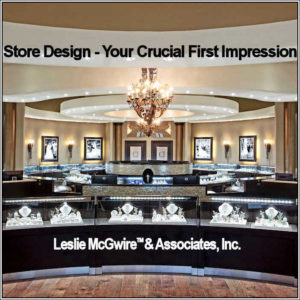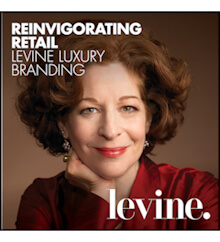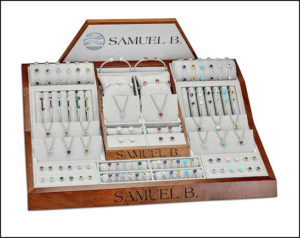In Store Brand Experience
Here’s an exercise all jewelers should do regularly in their store. Walk in thinking like your customer.
As you approach, what do you notice about the storefront, the signage, and the window displays?
When you walk in what draws your eye first? How do you feel the moment you walk in the store? Does your store give a welcoming vibe that invites exploration or is everything locked behind glass in a highly formal environment?
Consider the overall impression, and then go into the details of how your products are merchandised, how your store is decorated, how traffic flows, how your staff interacts with customers.
 Pam Levine, president of Levine Luxury Branding, who spoke about visual merchandising in a Plumb Club podcast, finds the exercise of walking in your customers’ shoes extremely impactful. “It is so important to look through the eyes of your customer. What you should discover are fresh ways to showcase, arrange, and highlight special categories and collections that engage and sell.”
Pam Levine, president of Levine Luxury Branding, who spoke about visual merchandising in a Plumb Club podcast, finds the exercise of walking in your customers’ shoes extremely impactful. “It is so important to look through the eyes of your customer. What you should discover are fresh ways to showcase, arrange, and highlight special categories and collections that engage and sell.”
First Impressions
First impressions never get a second chance. “You only have one chance to make a good impression, and so does your store,” underscores Leslie McGwire owner of Leslie McGwire & Associates. She not only exhibited in The Plumb Club Pavilion’s Innovation Section, but she also hosted a recent podcast for the group.
“Your store’s entrance needs a visual hook to fix a customer’s attention and give them the right sensory information that causes them to stop and think, ‘there’s something here for me’,” says McGwire, who has 35 years of experience in retail design, specializing in jewelry store design.
As a customer walks through the entrance those first sensory clues, such as visual, what are they seeing? Sound, what do they hear? Scent, how does the store actually smell? The first sensory clues they encounter cause them to form opinions about your store immediately.
“Those initial clues will help them decide whether your business is a professional establishment, and if you fit their self-appraisal as to whether or not they should trust you for advice and products that they may wish to purchase,” McGwire explains. It’s about creating an impression for the first-time visitor that is reaffirmed each time a repeat customer enters the store.
So many details go into that first impression, from lighting and flooring to wall colors and jewelry case design.
Go with the Flow
The flow of your store is crucial for not only your clients, but also your staff McGwire underscores. “How you move through the store is very important.” She notes that many studies find that customers naturally turn right when they enter a store. “I’ve observed this so many times,” she confirms. “This is where the most important jewelry category ought to be, whether it is bridal, fashion, or watches.”
Start at the window and move across the threshold, here are areas to feature those things that best represent what your store is known for, Levine concurs. “Perhaps it’s something new or relevant to the season. Are you featuring a new collection or designer? Do you have an upcoming event to promote? “
Levine advocates jewelers take their customers on a journey throughout their store, make it a game, a hunt, or a marketing campaign. Think about how you can surprise, delight and stimulate the sense of discovery and desire for mementos. Think about making products more accessible to invite browsing and help customers find what they are looking for.”
McGwire advocates “a consistency of style and function” throughout the space that ties in the whole jewelry shopping experience. “Your store’s interior needs to convey what your brand stands for and inspire a customer to trust you to help them make a purchase decision.”
The one thing that jewelers should never compromise on, McGwire says, is the quality of their jewelry cases. “Jewelry case design is extremely important for the overall look of the store. Where you show your diamonds, your jewelry cases should be the highest quality of cabinetry. Having high-end jewelry cases says a lot about your store.” It also is important that jewelry cases be functional and easy for sales associates to reach merchandise, drawers and storage space.
Levine reminds jewelers to freshen up displays by changing up the jewelry arrangements often. She underscores that displays should continue the story of a jeweler’s brand right down to the product. Showing rows of merchandise do not provide a memorable or different experience.
Create a few focal-point displays with a less-is-more approach to feature top sellers or most aspirational jewelry items, says Cora Lee Colaizzi, marketing director and senior merchandiser for Quality Gold. Avoid trying to fit in too much product in every case. Your goal is to draw the customer’s eye through a logical progression. Arrange presentations with proper space, focus and lighting.
Many jewelry brands provide their retail partners with displays that help tell a brand or collection story and usually in a way that maximizes small space. The designer brand Samuel B. offers an effective brand display for its bestselling birthstone jewelry program.
“The 70-unit presentation is designed with a small footprint, best angle for product viewing, and stocks 14 popular colors,” describes Mathew Behnam, vice president of sales and marketing for the designer brand. “We’ve taken a great deal of time to make sure our custom displays are not only attractive but are easy for sales associates to take products off and put them back on, and sized to fit most showcases.”
Similarly, Imperial Pearl has a signature display for its fastest turning premier Akoya pearl jewelry. Kathy Grenier, vice president, business development for the pearl house describes the presentation as compact and user-friendly, giving their retail jewelers a competitive advantage.
McGwire suggests that about every five years, jewelers should look closely at what needs to be replaced in their store – new jewelry cases and display elements, fresh paint on an accent wall, replacing flooring in high traffic area, and changing out light boxes and art. “This is the time to update your brand image.”
Levine underscores that every detail contributes to the experience, and the experience needs to fully support your brand, both in store and through all channels of engagement (website, social media, community involvement).


